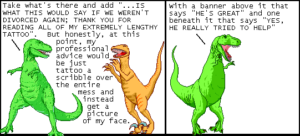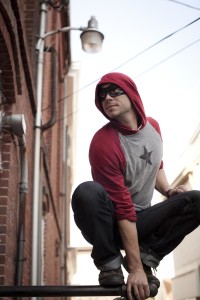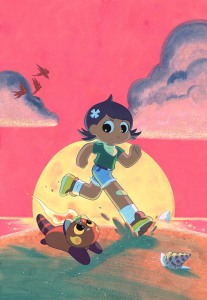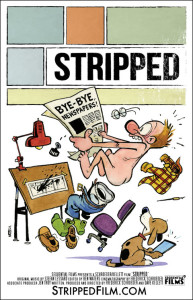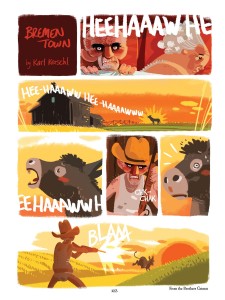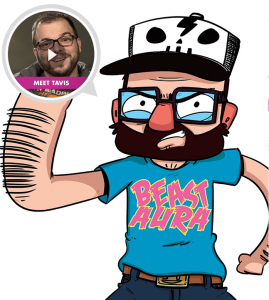Let’s get the obvious bit out of the way first — if Hope Larson very generously offers to make time for you between signings so you can talk, you jump on that.
She’s one of the all-time great creators we’ve got right now, but ironically she’s becoming known widely not for her stellar work on original graphic novels (which fairly burst with heart and honesty), not even for her graphic adaptation of one of the best-beloved science fiction novels of all time, but because she’s working on a BOOM! series¹ and about to launch the next phase of Batgirl. There’s a lot to unpack there, and she spent a lot of time finding the crux in each question and answering it as thoroughly as she could.
On writing for other people to draw
Larson’s been a writer/artist for the vast majority of her career, but she’s just wrapped up the first four issues of Goldie Vance with Brittney Williams and is working directly with Rafael Albuquerque. It’s a shift, but she doesn’t feel restricted by it because she’s got trust in her artists. I’ve never had an art conflict on any book is how she put it, which may be the first time in comics history that’s been said.
She’s found the challenge is less figuring out how to direct the visuals in her head to the page via the hand of another, and more figuring out how to break up the story into 20 to 24 page chunks. Looking at past work like Chiggers or Mercury, it’s easy to see her storytelling rhythms tend toward the slow buildup, centered on emotional states and inner feelings seeking their way out.
Having to reach a mini-climax in less than two dozen pages, where every single one has to move plot forward to be a satisfying, standalone read, and deal with the fact that readers may be coming in without having seen the earlier issues makes for a completely different style of work. But if you’ve read Goldie Vance, you see that it’s worked out really well.
On that Space Age that isn’t horribly, horribly racist
If you haven’t read Goldie Vance, it’s in an resort area of Florida in the Mercury/Gemini era, and it features a fully integrated society. All ethnicities are interacting with each other (although there’s some tension), Goldie herself is interracial, and her father’s the one in charge of the hotel (although it’s got an absentee owner who’s white). It’s maybe the vision that people have of what the Civil Rights era was like when they convince themselves that they totally would have marched with Martin Luther King, Jr, and absolutely would have subjected to the firehoses, dogs, mobs, and arbitrary jailings. It’s not our world, and it’s not a romantic obliviousness that led to this version of Past America being portrayed.
No matter how you write that era, it’s going to be problematic, Larson told me. You either have to turn a blind eye, or you have to have a world where it wasn’t like it was here. It’s a fantasy. It was also a deliberate choice, since the focus of Goldie isn’t struggle, inequality, history, it’s a girl’s adventure like you’d get from a much hipper Nancy Drew.
I asked if the approach was to treat the comic like a TV show or movie that used completely race-neutral casting, and she agreed; If it ever became a TV show, I hope it would be cast that way.² So look at it as if our national feelings of self-congratulation at the time — we’re living in Camelot! — were actually justified. If it’s unreal, but unreal in a way that lets girls who haven’t seen themselves as the protagonists of comics before get to (cf: Ben Hatke’s Little Robot), then that’s worth a bit of unreality … and what are comics for if not the fantasy?
On getting the look just right
Larson gives Williams all the credit for the hazy, sun-dappled look of Goldie Vance’s environments and the vivacious, lively look of the very diverse characters. I can be sparse with my descriptions for Brittney, because she’s going to give me amazing environments. The best thing I can do is give her room.
With Four Points (the graphic novel series title for the just released Compass South and next year’s Knife’s Edge, both illustrated by Rebecca Mock) and Batgirl, she’s writing about real places at real points in time, she can be much more specific in her scripting and supply photo reference; knowing the people, clothing, and buildings will look the way they do in her head likely (and I’m speculating here, because I’m just now realizing that I didn’t ask this and I’m kicking myself) frees her to think more about the page and the scene it conveys. This bit here is basically just an excuse to transition into discussing her thoughts …
On scripting fight scenes
I asked Larson if it was viscerally satisfying to be able to write BATGIRL roundhouse-kicks THUG #2 in the face and he goes FLYING BACK THROUGH THE WINDOW. I love it! It’s the single thing I’m most excited about! She shared that while she thought working on Batgirl would be weird, it’s just been fun, with the chief advantage being you don’t have to build up a character because she’s already there.
When I noted the essential ephemerality of super heroes — that in a few years somebody might come along and cancel out everything she’s ever written because it ruined their childhood and now they can make Batgirl the way she was always supposed to be — she was nonplussed. If you go to the wikis, every story arc is there; it’s all there forever, even if it’s contradicted, and for some people, it will be the first Batgirl they ever read.³
On the biggest challenges of writing superheroes
I asked if DC’s famously heavy editorial hand (You must get this story point in here to reference this line-wide crossover event, no matter how much of a misfit it is in your own story) was constricting. She said that Batgirl has been a process of discovery, and she’s grateful for the guidance her editors have provided in helping her figure out Cape Logic. I was worried about getting the details right, you know, Barbara’s running down an alley, and then in the next panel she’s Batgirl, and where was she keeping the boots? And my editors said, “It’s okay, don’t worry about it.”
Freed from the illogic of costume-stashing, she’s thrown herself into getting correct the things that can be done right or wrong. The second book in the arc is going to be MMA-themed, so I’ve learned a lot about the history of MMA, how it works, read a lot of articles and watched a lot fights. I don’t get MMA, but if Larson’s let that inform the fight scenes in Batgirl, I think we’re going to see a lot more plausibility there.
On the future
Goldie Vance is creator-owned with Williams, but she won’t be on it forever. Down the line, new people may be found to write or draw it, which would put her on the other side of the work-for-hire arrangement. She’s got pitches (that she can’t talk about, naturally) in process now, and multiple books due (both solo and with artists) between now and 2020; that guarantee of work is reassuring, and there’s enough room in her schedule to pick up or launch new work in the meantime.
If she could pick any existing characters to write, they would be Wonder Woman and the Gotham villain ladies — Poison Ivy, Catwoman — that go back and forth from sorta-baddie to sorta-hero. If she could work with any artist for the first time, she’s spoiled for choice. Every young artist coming up right now is amazing.
She considers Goldie and Batgirl to have raised her profile and name recognition in the industry considerably; I was surprised by that since I spend a significant amount of time waiting for her next release, but that’s the nature of comics — different audiences, different sizes.
She hopes to use that profile to work with people who wouldn’t otherwise get the art or writing gigs. While Goldie Vance was cast race-neutral, the comics industry as a whole hasn’t done a good job of diversifying the pool of creators who are hired and developed; Larson firmly believes that more viewpoints can only make for more and better stories and is doing her best to nudge the parts of the industry that she interacts with in that direction.
Which, when I spend even half a second to think on it, is entirely obvious. Her work has always been marked by empathy and the conscious effort to find the humanity in every character. In her work, Hope Larson reveals a love for this messy, contradictory world all the messy, contradictory people in it. She wants to tell the stories she can tell, and hear the stories that they can tell. The sooner we put that aspiration at the center of Comics-With-A-Capital-C, the better.
_______________
¹ Creator-owned, so allow me to cynically hope that she’s getting less screwed than those BOOM! contracts for licensed titles; please note that I am expressing an opinion here and not conveying anything Larson said.
² Similarly, Gina Davis has proposed a simple first step to try to drag gender equality into the film and TV industry: every time a crowd scene is written, it should specify that half of the people present are women. Without that instruction, women are underrepresented in the crowds, which means they’re underrepresented in the consciousness of everybody watching that scene. It’s true in any visual medium — check out background scenes in comics and ask yourself how many white dudes there are there as opposed to every other type of person.
³ That sense of preservation in the face of retcons struck me as similar to Alan Moore’s response when asked if a particular film adaptation ruined the comic it was based on: he pointed to the bookshelf and noted the comic was still there.

